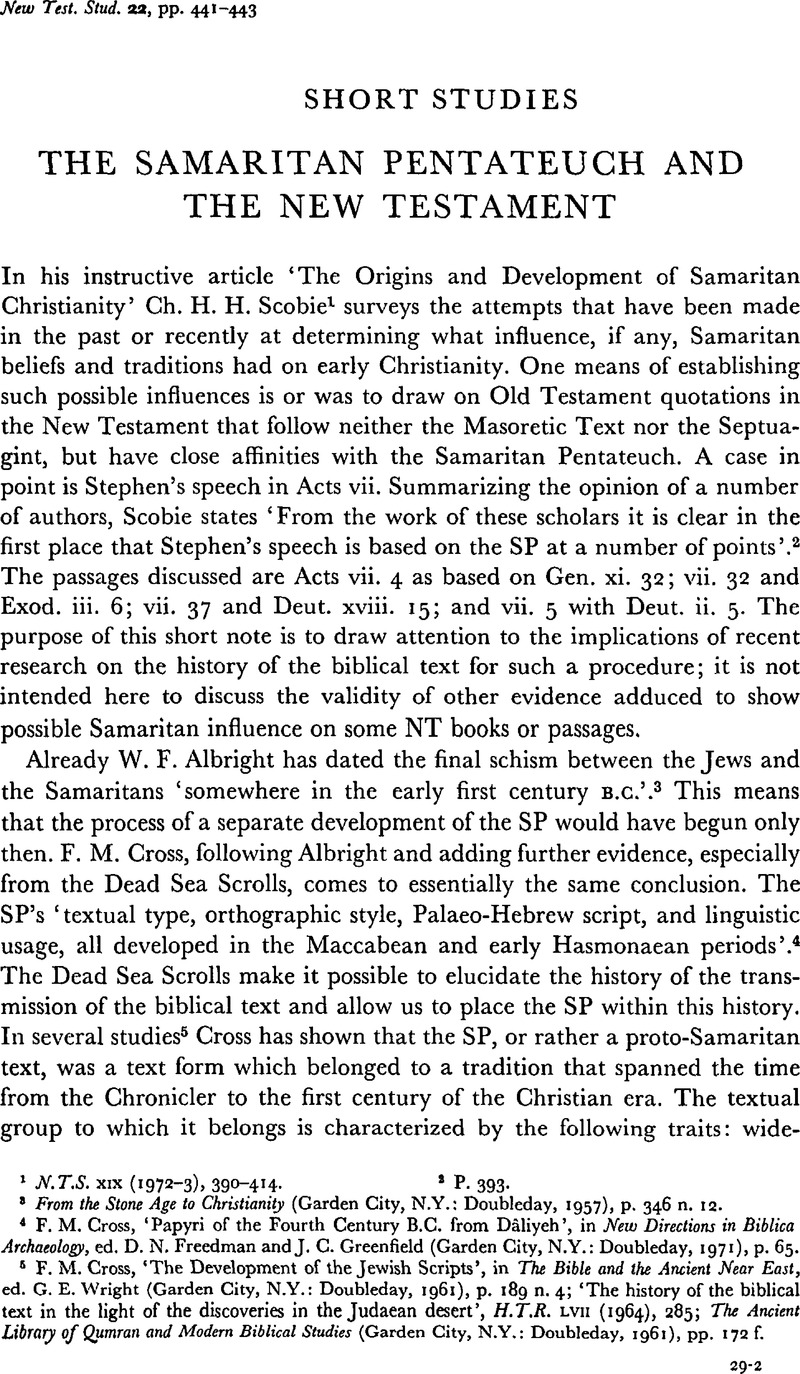Published online by Cambridge University Press: 05 February 2009

page 441 note 1 N.T.S. XIX (1972–3), 390–414.Google Scholar
page 441 note 2 p. 393.
page 441 note 3 From the Stone Age to Christianity (Garden City, N.Y.: Doubleday, 1957), p. 346Google Scholar n. 12.
page 441 note 4 Cross, F. M., ‘Papyri of the Fourth Century B.C. from Dâliyeh’, in New Directions in Biblica Archaeology, ed. Freedman, D. N. and Greenfield, J. C. (Garden City, N.Y.: Doubleday, 1971), p. 65.Google Scholar
page 441 note 5 Cross, F. M., ‘The Development of the Jewish Scripts’, in The Bible and the Ancient Near East, ed. Wright, G. E. (Garden City, N.Y.: Doubleday, 1961), p. 189Google Scholar n. 4; ‘The history of the biblical text in the light of the discoveries in the Judaean desert’, H.T.R. LVII (1964), 285Google Scholar; The Ancient Library of Qumran and Modern Biblical Studies (Garden City, N.Y.: Doubleday, 1961), pp. 172 f.Google Scholar
page 442 note 1 Cross, , ‘Contribution’, pp. 83, 86.Google Scholar
page 442 note 2 Cross, , The Ancient Library, p. 173.Google Scholar
page 442 note 3 Cross, , ‘Contribution’, p. 85.Google Scholar
page 442 note 4 Baillet, M. in his article ‘Le texte samaritain de l'Exode dans les manuscrits de Qumrân’ in Hommages à André Dupont-Sommer (Paris: Librairie d'Amérique et d'Orient, Adrien-Maisonneuve, 1971Google Scholar), does not once mention Cross's new findings; after studying Exodus as it is known from umran, he comm to the conclusion that ‘certains manuscrits de Qumrân contiennent, non seule-ment des éléments samaritains disséminés, mais le texte samaritain lui-même’ (p. 380). The absence from Qumran texts of the passage that is most clearly of a sectarian nature, viz. the interpolation after Exod. xx. 17 (cf. Skehan, P. W., ‘The Scrolls and the Old Testament Text’, in New Directions in Biblical Archaeology, p. 101Google Scholar, and ‘Qumran and the Present State of Old Testament Text Studies: The Masoretic Text’, J.B.L. LXXVIII (1959), 22 C.Google Scholar), is passed over in silence by Baillet.
page 442 note 5 Skehan, P. W., ‘The Scrolls and the Old Testament Text’, p. 103.Google Scholar
page 442 note 6 Cf. what Skehan says: ‘Actually no attempt at a general statement of the value and special characteristics of the different branches of OT textual tradition (Masoretic, LXX, Samaritan, etc.) can in future be made which does not base itself firmly on the factual data and the necessary inferences here given by Cross’ ( ‘Two books on Qumrân studies’, C.B.Q. XXI (1959), 77).Google Scholar
page 442 note 7 See Scobie's notes.
page 443 note 1 Cross, , ‘Contribution’, p. 86.Google Scholar
page 443 note 2 There is no need for a harmonization of the kind which Mare tries to present ( Mare, W. H., ‘Acts 7: Jewish or Samaritan in Character?’, Westminster Theological journal XXXIV (1971–72), 18 f.Google Scholar).
page 443 note 3 Cf. also Bouwman, G., ‘Samaria in Lucas-Handelingen’ Bijdragen XXXIV (1973), 53.Google Scholar
page 443 note 4 See Skehan, P. W., ‘Exodus in the Samaritan recension from Qumran’, J.B.L. LXXIV (1955), 182–7Google Scholar; ‘The Scrolls and the Old Testament Text’, pp. 101 f.
page 443 note 5 Skehan, P. W., ‘Bible, IV (Text and Versions)’ in New Catholic Encyclopedia (New York: McGraw-Hill, 1967), II, 417.Google Scholar
page 443 note 6 Skehan, P. W., ‘Bible, V (Textual Criticism)’ in New Catholic Encyclopedia, 11, 493.Google Scholar